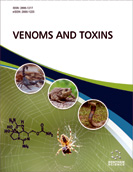Abstract
Background: Adansonia digitata has been used as a traditional medicine to treat various diseases including snakebite envenomation.
Objective: In this study, the protective and ameliorative potentials of crude methanol extract of Adansonia digitata fruit pulp against crude venom of Naja nigricollis in-vitro and in-vivo were investigated.
Methods: The dose-dependent inhibitory studies, pharmacological, histopathological and in vivo studies were conducted using standard methods.
Results: The mean lethal dose of the crude methanolic extract of Adansonia digitata fruit pulp in Wistar rats was > 5,000 mg/kg, while Naja nigricollis venom was 0.89 mg/kg. The anti-lethality effective concentration of the fruit pulp on Naja nigricollis venom was 92.52 mg/ml. Treatment significantly (p < 0.05) inhibited the activities of Naja nigricollis phospholipase A2 and dose-dependently reduced Naja nigricollis venom-induced paw oedema at 1-4 hours post-envenomation. In-vivo, treatment with 250 and 500 mg/kg of Adansonia digitata fruit pulp was protective against the clinical signs and mortality. Serum acetylcholinesterase activities were maintained in the group treated with normal saline and the ameliorative groups but decreased significantly (p < 0.05) in other groups. Brain acetylcholinesterase was high in all the groups by day 1 but was reduced with increasing dose by day 2 in the ameliorative groups only. Adansonia digitata fruit pulp also preserved the histoarchitecture of the brain, heart, liver and spleen from venom-induced pathologies.
Conclusion: Crude methanolic extract of Adansonia digitata fruit pulp possesses good protective and ameliorative neutralization effects on Naja nigricollis venom and could be promising in the management of snakebite envenomation.
[http://dx.doi.org/10.1186/s40409-017-0127-6] [PMID: 28804495]
[http://dx.doi.org/10.3390/toxins9050163] [PMID: 28505100]
[http://dx.doi.org/10.1016/S0140-6736(05)74319-1] [PMID: 11145528]
[http://dx.doi.org/10.1093/trstmh/trv088] [PMID: 26626337]
[http://dx.doi.org/10.1016/0024-3205(87)90126-3] [PMID: 3561167]
[http://dx.doi.org/10.1021/bi00684a012] [PMID: 1148181]
[http://dx.doi.org/10.1016/j.imr.2017.03.001] [PMID: 28664135]
[http://dx.doi.org/10.1016/j.sajb.2011.08.010]
[http://dx.doi.org/10.1016/S0304-4017(03)00154-7] [PMID: 14519322]
[http://dx.doi.org/10.1111/j.1365-2141.1967.tb00754.x] [PMID: 6067638]
[http://dx.doi.org/10.1007/s10646-006-0089-x] [PMID: 16937075]
[http://dx.doi.org/10.1016/0272-0590(85)90059-4] [PMID: 3987991]
[http://dx.doi.org/10.1016/0041-0101(86)90199-6] [PMID: 3715904]
[http://dx.doi.org/10.1007/978-1-4684-0886-7_10]
[http://dx.doi.org/10.1016/0041-0101(89)90098-6] [PMID: 2781585]
[http://dx.doi.org/10.1016/0006-2952(61)90145-9] [PMID: 13726518]
[http://dx.doi.org/10.19026/bjpt.4.5376]
[http://dx.doi.org/10.1016/j.phyplu.2021.100034]
[http://dx.doi.org/10.1111/j.1471-4159.2006.03965.x] [PMID: 16805767]
[http://dx.doi.org/10.1016/j.jksus.2014.01.003]
[http://dx.doi.org/10.3390/molecules23123104] [PMID: 30486448]
[http://dx.doi.org/10.1016/j.sajb.2019.01.034]
[http://dx.doi.org/10.47836/ifrj.28.1.03]
[http://dx.doi.org/10.1186/s13049-015-0179-y] [PMID: 26561300]
[http://dx.doi.org/10.1016/j.biopha.2017.10.079] [PMID: 29091868]
[http://dx.doi.org/10.25026/jtpc.v5i4.296]
[http://dx.doi.org/10.5897/JMPR2020.7079]
[http://dx.doi.org/10.4103/0973-7847.99898] [PMID: 23055633]
[http://dx.doi.org/10.4269/ajtmh.16-0842] [PMID: 28138054]
[http://dx.doi.org/10.1371/journal.pone.0132569] [PMID: 26193352]
[http://dx.doi.org/10.1016/S0031-9422(00)00229-6] [PMID: 11130675]
[http://dx.doi.org/10.2174/1872208314666200903152129] [PMID: 32885765]
[http://dx.doi.org/10.1016/j.ibror.2019.09.042]
[http://dx.doi.org/10.1080/10495398.2015.1102147] [PMID: 26913549]
[http://dx.doi.org/10.9734/arrb/2021/v36i730395]


